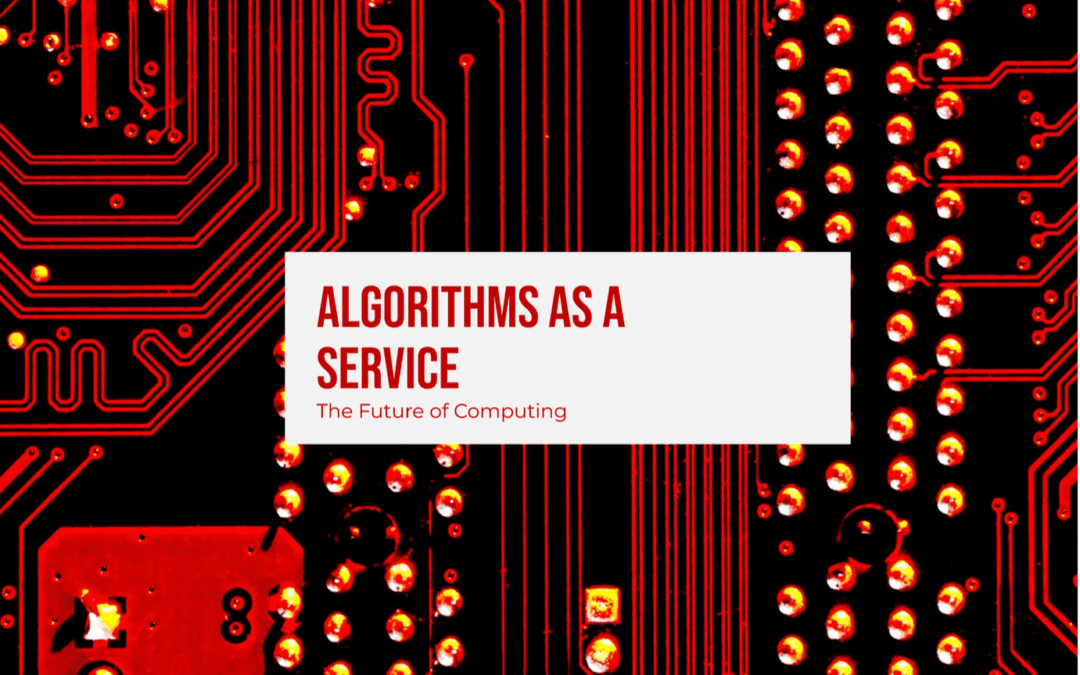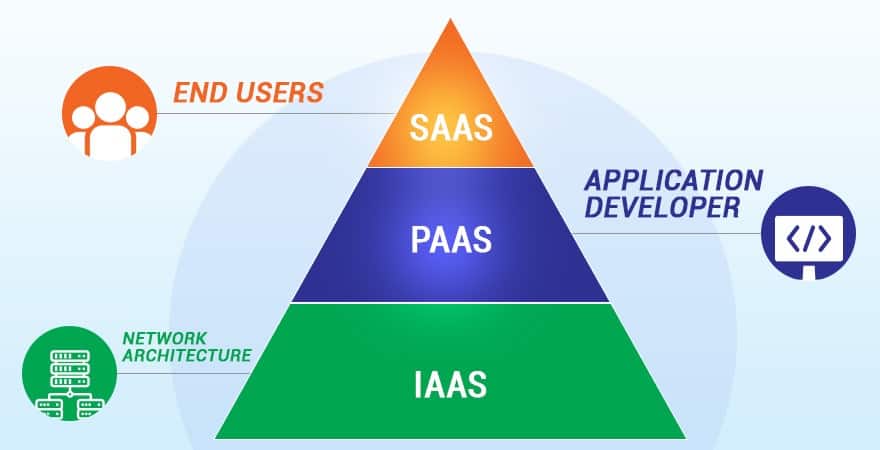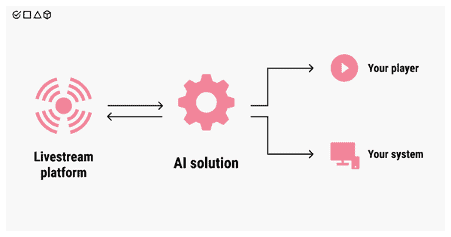Introduction
As business leaders, you know that computing has changed dramatically in recent years.
The Cloud, Big Data, and Artificial Intelligence are all reshaping how we do business. But what’s next?
History may offer a clue.
Before the turn of the century, organisations frequently invested in building bespoke business systems. Large teams of in-house software developers produced millions of lines of computer code, often with little engagement from the business. These systems replicated standard business processes electronically and were transactionally based rather than customer-centric. As a result, building systems internally rarely differentiate organisations from one another.
After the Millennium “Y2K” problem, many organisations began to doubt the effort and cost of building their systems. Buying off-the-shelf business applications became popular because it was a more efficient way to solve the problem. While creating massive monolithic systems was left to the minority, this method is becoming less popular because of the rise of microservices.
Most people started buying business applications that were already made instead of making their own extensive, complicated systems like they used to. This happened because people had to deal with the “Y2K” bug in 2000.
Fast forward to the present day, and Data Science is the next big thing. Many businesses are allocating significant time and money into building their in-house capabilities in response to the risks of falling behind the competition. However, as the complexity and governance demand increase, will some people again question the rationale of this approach and instead opt for ready-made solutions? Could algorithms as a service be a viable alternative to building algorithms in-house?
The short answer is yes. Algorithms as a Service represent a new category of software that allows you to use pre-built algorithms without developing and maintaining them.
This article will explore algorithms as a service and how they will change how businesses operate.
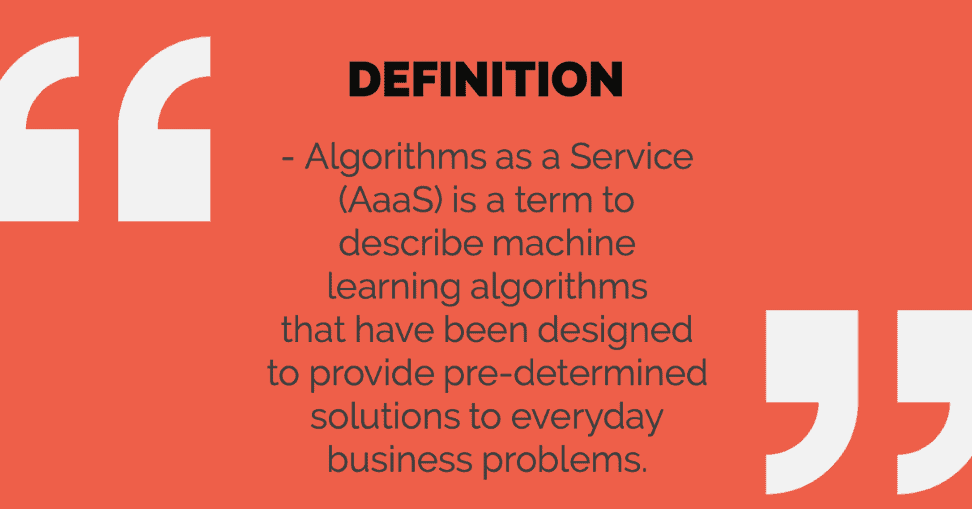
PART I
1. What are Algorithms as a Service?
Algorithms as a service, or AaaS for short, is the term given to a new area of cloud computing in which algorithms are offered as an AI service. The service contains a library of pre-built machine learning algorithms explicitly designed to address common business problems.
AaaS provides businesses access to predictive models made available over the web, allowing them to remove the associated overheads of building their own. In turn, organisations can focus on their core business whilst leaving the development of algorithms to specialist tech firms who can do it more quickly and efficiently.
We’ll see in Part III in-depth information on the different types of algorithms and how they learn.
2. Why are algorithms as a service important now?
As explained in the previous section, this innovative AI service is a potential game-changer for organisations and represents a new way of doing business.
Many organisations have built their machine learning models to solve common business problems. This AI development is often costly and time-consuming, requiring in-house Data Scientists, AI Developers, and specialist Data/Cloud Engineers. In addition, the truth is that most machine learning models being built do not require novel solutions.
Organisations adopting AaaS can fast-track their data science capabilities using pre-built models designed to address the most common business problems.
It takes a wide range of technologies and operational capabilities to provide an AaaS solution. Such services offer end-to-end platforms in which algorithms can run.
Examples of what goes into an AaaS AI platform are:
- AI capabilities
- AI frameworks
- AI tasks
- AI development
- AI tools
- Cloud services
- AI infrastructure
- Cyber Security
- AI-based technologies and environments
- AI experts
- Data Scientists
- Data Engineers
- Cloud Solution Architects
- Quality Assurance
Consequently, these AI platforms significantly speed up the time to deploy new algorithms, as all the hard work has been done. This enables companies to free up internal resources, including internal data scientists, to focus on other AI tasks that could help differentiate their organisation. The net result is that companies can achieve results faster and more efficiently, which helps drive profits and provide a competitive advantage.
Furthermore, as AI models become increasingly sophisticated and businesses employ larger data sets, they will need people with AI expertise to develop and use algorithms. This raises the demand for such specialised skills, increasing employee turnover and wages. Finally, increased staff turnover slows a company’s progress as knowledge is lost in the market. This depletes the competitive advantage that a company may have held.
Algorithms as a service can help solve some of these problems by making it easy for people to access algorithms.
3. What are the benefits?
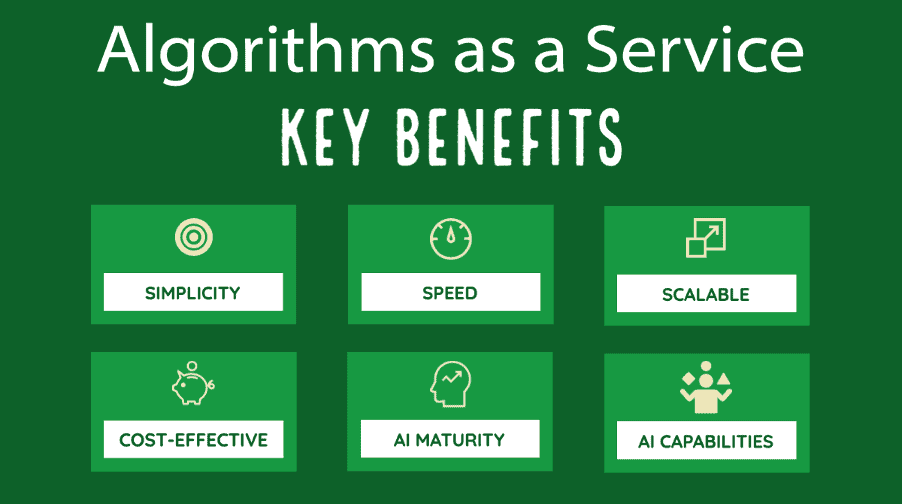
Simplicity
It can take a long time to develop and train AI models before you can use them. With a service, you immediately access many algorithms, eliminating the demand for hiring experts and developing and supporting complex infrastructure.
AaaS offers a mechanism to expose machine learning models via programmable interfaces (APIs). These APIs provide a simple method of connecting business systems and sending data back and forth.
AaaS solutions also often include AI tools for monitoring and controlling the runtime behaviour of AI models. This vastly simplifies operational matters and avoids the need for additional infrastructure.
Speed
Solutions are packaged to solve common business problems, significantly reducing the time spent on AI projects.
AaaS models benefit from being used by large numbers of companies. Shared learnings can be used to optimise algorithms and improve accuracy levels. As a result, the insights generated by algorithms are considerably sped up. This characteristic can be particularly desirable to smaller companies with insufficient data sets to train models sufficiently.
Scalable
Hosted in the Cloud on third-party infrastructure, AaaS solutions enable organisations to scale up or down their business demands as they need it. This inherent flexibility makes it ideal for organisations with limited technical capabilities.
Cost-effective
Organisations avoid the risks and costs of building their solutions/capabilities.
Fees are transparent, with companies only paying for what they use. This avoids paying for AI functions that aren’t needed and avoids significant upfront capital costs.
In addition, with the growing concern over environmental sustainability, many businesses are looking for ways to reduce their energy consumption and waste. AaaS has a lower impact than building in-house. This will become more important as organisations develop policies that recognise the positive effects of technology on society.
AI Maturity
By integrating with AaaS solutions, organisations instantly grow their ecosystems and thus increase their technical capabilities. This is particularly beneficial for non-technical businesses. Creating unique algorithms is hard, and using them programmatically can be painful. AaaS overcomes this and provides a bridge between Data Scientists and the business.
AI Capabilities
Finding the right people with the necessary AI skillsets and business knowledge is becoming increasingly complex, and many companies are chasing the same pool of resources. This situation has intensified recently following the pandemic as businesses realise the importance of IT more than ever.
Data Scientists are no exception, and recent wage inflation has made it difficult and cost-prohibitive for many smaller organisations to adopt AI. AaaS negates the need for in-house AI experts, thus avoiding the cost and associated risks of recruiting and managing highly skilled personnel.
4. How does it work?
AaaS provides an end-to-end platform for distributing, operating, and monetising algorithms, effectively “enriching” the company’s data with new insights and elevating decision-making.
Algorithms made easy: 6 steps to success with AaaS
- Integrate AaaS with existing business systems using secure APIs.
- Feed customer or product data into the service.
- The targeted algorithm(s) process the input data in near real-time.
- Multiple algorithms perform complex calculations simultaneously, keeping the machine learning processing time to a minimum.
- The service then returns specific predictions or calculations on the data.
- Downstream business processes use the new insights to enhance decision-making.
AaaS solutions are composed of three main components:
- Algorithms
- Data
- Complex Infrastructure
Algorithms
Algorithms are the heart of AI and machine learning technology. In AaaS solutions, algorithms have been developed and packaged to provide solutions and predictions for specific business problems.
Data
Raw data is the fuel that feeds the algorithm.
During the early phases of implementing an AaaS solution, AI models are trained and optimised on a company’s data. This training uses a sample of the organisation’s data to ensure that the data quality is sufficient and that the results returned from the algorithm are as expected.
Over time, the algorithm’s predictions may lose accuracy because the data being used has changed– known as data drift. Data drift can happen for several reasons, such as the seasonality of the data or a change in consumer preferences. Upstream business systems may also change, leading to missing values in the data.
AaaS providers have developed methods to detect and mitigate such data drift. Having robust data governance, data preparation tools, and regularly re-training models are some of the best practices to expect from AaaS vendors.
Infrastructure
Infrastructure includes everything needed to support algorithms, such as specialised hardware, software, and cloud services.
Many AaaS providers use third-party Cloud solutions that can be quickly and easily set up. Businesses don’t need to worry about supplying and maintaining their hardware.
A unique selling point of AaaS solutions is providing businesses with an easy-to-use interface. Many technical barriers have often been removed to increase the adoption of their service. Partnerships and integration with commonly used business systems are a usual approach and give the AaaS vendor the added benefit of gaining a degree of distribution for their product. This simplifies and speeds up the implementation of such services whilst limiting any technical overheads, meaning the organisation doesn’t require deep prior knowledge before use.
PART II
1. What are some common uses for AaaS?
There are many different types of pre-built algorithms that you can use to solve business problems. Below are three typical examples, each focusing on a particular area.
1. Detecting financial fraud
Machine learning algorithms can be pre-built to detect financial fraud. This includes understanding patterns in data that may indicate fraudulent activity.
This information may be used by businesses to protect themselves from financial losses and to increase their profits.
2. Analysing social media
Machine learning can be used to read millions of social media posts. This includes identifying the words used and understanding the context in which they appear.
3. Predicting Consumer Behaviour
Businesses can use pre-built algorithms to predict what a customer might do next, and this is based on their past behaviour and the current situation.
This information may be used to show what advertisements will be most effective or to give a more personalised service. Companies might also use this information to suggest products you might be interested in.
A good example of this is the insurance industry which is using machine learning to predict better what will happen, which helps them make better decisions in real-time. For instance, an improved understanding of the future likelihood of a claim, the lifetime value of a customer, and the future likelihood of renewal can help underwriters determine a policyholder’s risk and optimise the price.
These examples are just the tip of the iceberg, with machine learning models used in every conceivable aspect of your business.
2. What are the downsides?
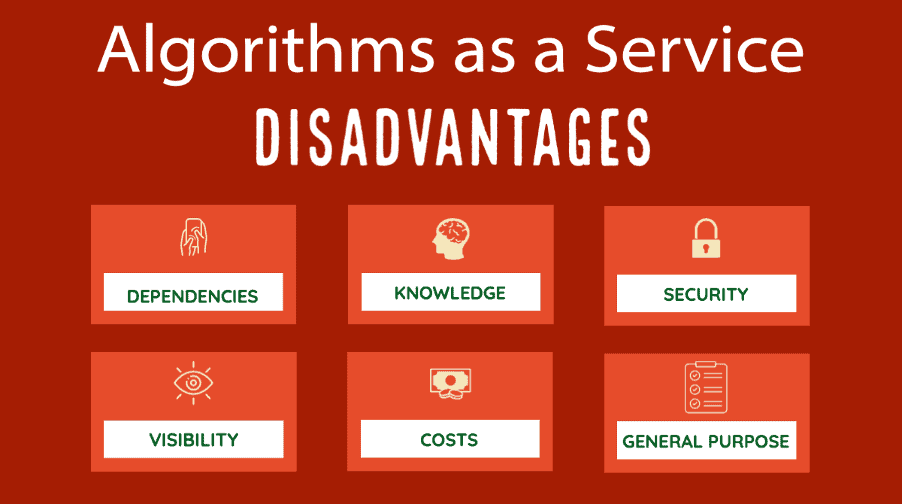
Dependencies
When a platform gets good at something, it can save businesses time and money and avoid them needing to develop it themselves. This is because the platform has already worked hard to create this capability.
The downsides are that these solutions can create significant dependencies that businesses become reliant on.
Knowledge
Machine learning is a complex part of computing that only a few people understand.
When companies use AaaS solutions, they get pre-trained algorithms that provide insights into business outcomes. This is instead of understanding the technology itself deeply.
Security
You need to share company data to use a hosted algorithm to make predictions. But this can create security and privacy concerns.
You need to be sure that the SaaS Vendor has the proper security procedures in place. They should only have access to the data they need to provide their service. The vendor should also only use the data for its stated purpose.
Visibility
Machine learning is often described as a black box. So, while AaaS solutions offer greater transparency in costs, you are only paying for a service, not access to the system’s inner workings. In other words, you know what goes in and comes out, but you may not be given any insight into how the models come up with the results.
Ensure the AaaS vendor can provide transparency and a history of how decisions are calculated.
Long-term Costs
AaaS can help you save money while you are growing your business. However, remember that it is a service that charges you based on how much you use it. If you use more algorithms, the costs will be higher. This usually happens if a company has already had some success and then decides to use AaaS more.
General Purpose
SaaS vendors fast-track data science capabilities by offering a library of pre-built models specifically developed to address the most common business problems.
However, more sophisticated models may need to be built from scratch for complex problems, which may not be achievable using AaaS solutions.
3. What’s next for Algorithms as a Service?

Algorithms as a Service is still in its early stages of development. Still, it is already positively impacting how businesses operate.
As technology develops, we expect to see more innovative and revolutionary applications of AaaS across all sectors. The demand for Algorithms as a Service is expected to grow to US$43.29 billion by 2030, with businesses under pressure to utilise algorithms.
Modern technology’s modularising influence will continue to facilitate the reconfiguration of business value chains. New specialised tech entrants will create a better version of the technology ecosystems. Complexity has made it challenging to distribute algorithms in the past. With the advent of AaaS, machine learning models will be accessible by anyone who wants them, including existing incumbents and new entrants.
In the future, algorithms will only become more complex. To stay commercially viable, AaaS providers will need to continue investing in their R&D programmes and developing new ways to make their algorithms accessible.
Areas of focus include:
- The development of self-learning algorithms that can be used without human intervention.
- Increased transparency and understanding of how algorithms work and their results.
- Improved security and privacy control to ensure data is protected and used ethically.
- Continued development of new use cases for algorithms as businesses seek to gain a competitive edge.
4. Conclusion
The parallels between companies’ building their software development in the past and the current race to implement AI solutions are remarkable. Whilst the drivers are different, the business response to the potential risk is the same – one of let’s “build” it ourselves.
Whilst this approach may suit some, for most, this presents a high-risk strategy that, over time, may not yield sufficient returns on investment.
For most organisations, an alternative strategy is to consume cloud-based services which offer pre-packaged algorithms. This “buy” approach certainly reduces entry barriers and enables companies to advance their data science capabilities more accurately and cost-effectively.
As we have seen, there are many benefits of AaaS. Perhaps the most important is that it enables companies to focus on their core competencies while outsourcing the development and maintenance of algorithms to specialist providers.
This is a crucial advantage for incumbents, who can now access the best algorithms without developing them themselves. It is also an advantage for new entrants, who can quickly enter new markets with little up-front investment.
Finally, with the growing concern over environmental sustainability, many businesses are looking for ways to reduce their energy consumption and waste. AaaS has a more negligible effect on the environment than building something in-house. This will be important for businesses as they develop policies that recognise the positive impact of technology on society.
Do you think Algorithms as a Service will transform the future of computing?
PART III
1. Terms frequently used in the post
What are algorithms?
An algorithm can be defined as instructions for solving a problem or accomplishing a task. There are various types of algorithms, which can be broken down into different categories.
Artificial intelligence algorithms are a subset of algorithms that have been specifically designed to simulate or perform human-like tasks.
Types of algorithms
Supervised algorithms are named as such, as they are given data that has been labelled upon which to “learn”. The algorithms iteratively make predictions and then are adjusted to the correct answer using this training data. This means the algorithm becomes optimised to know the right solution for each data item it processes.
Supervised learning is like learning from a textbook. The algorithm learns from training data and then applies that knowledge to new data. Supervised learning models are typically more accurate than unsupervised ones but require human intervention to label the data.
An example of a supervised algorithm would be a model that can predict how long your car journey will be based on the time of day. But first, this model needs training to know that rainy weather will likely extend the driving time.
Unsupervised algorithms are given unlabelled data from which to learn. The algorithm works independently to discover hidden patterns or groupings within the data.
Unsupervised learning is like learning from experience, and they make an ideal solution when exploring data or making recommendations.
Such algorithms have many advantages, but there are some risks. To avoid biased outcomes, AI developers must rely on human verification to decide what is reasonable. Transparency into why specific associations have been made is crucial as unsupervised algorithms can provide little insight into how they reached conclusions about the data.
An example of an unsupervised algorithm would be a model that can identify the behaviours of online shoppers who often purchase groups of products simultaneously. However, to show whether it makes sense to combine paper with an order of pens, pencils, and erasers, you need to validate that it makes sense.
Semi-supervised algorithms use data that is only partially labelled. In this scenario, the algorithm uses labelled data to learn and fill in the gaps of the rest of the unlabelled data. Using a semi-supervised algorithm is that it can make informed assumptions based on the labelled data.
This algorithm is widely used in image recognition, where much of the data is unlabelled. The algorithm can learn how to classify objects by referencing pictures that have been correctly labelled and categorised. It can also learn to recognise objects in photos that have not been tagged.
The cost to label data appropriately is often high due to the expertise and time required. So, semi-supervised or unsupervised algorithms can be a more appealing alternative without fully labelled data.
What is machine learning?
Machine learning is a term used to describe algorithms that learn from data.
They apply this learning to make predictions about new data. The accuracy of these predictions automatically improves over time as the algorithm processes more data.
Types of machine learning:
-
-
- Linear regression
- Logistic regression
- Decision tree
- Random forest
- Neural networks
-
ML Managed Services
The vendor manages all aspects of the machine learning models for you, from training to deployment.
Pre-trained Models
These machine learning models have already been trained on specific data sets and are ready to be used.
These machine learning models can be customised to your specific data set and needs.
Customisable models may be the best option if you have the time and expertise. Pre-trained models may be better if you need a quick solution ready to use. And if you want someone else to take care of everything for you, managed services are the way to go.
2. References
AI as a Service: An Advanced Solution for Your Business
AI as a Service (AIaaS) Market
Applications Of Machine Learning That Will Blow Your Mind
How AI Technology and New Data will Impact the Future of Insurance
Learn How Unsupervised Learning Works
The True Cost of Employee Turnover in Tech
Types of Machine Learning Algorithms You Should Know

